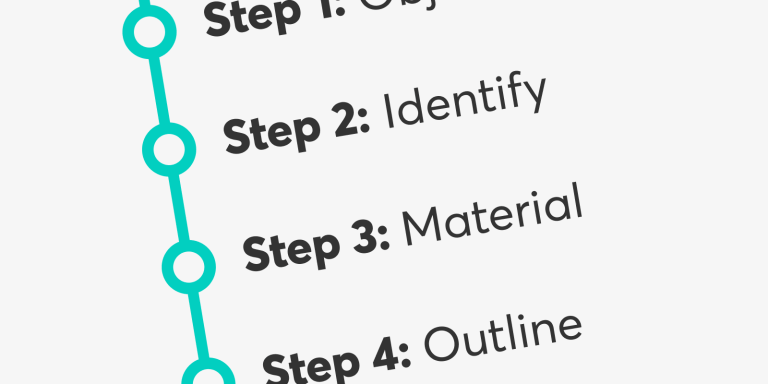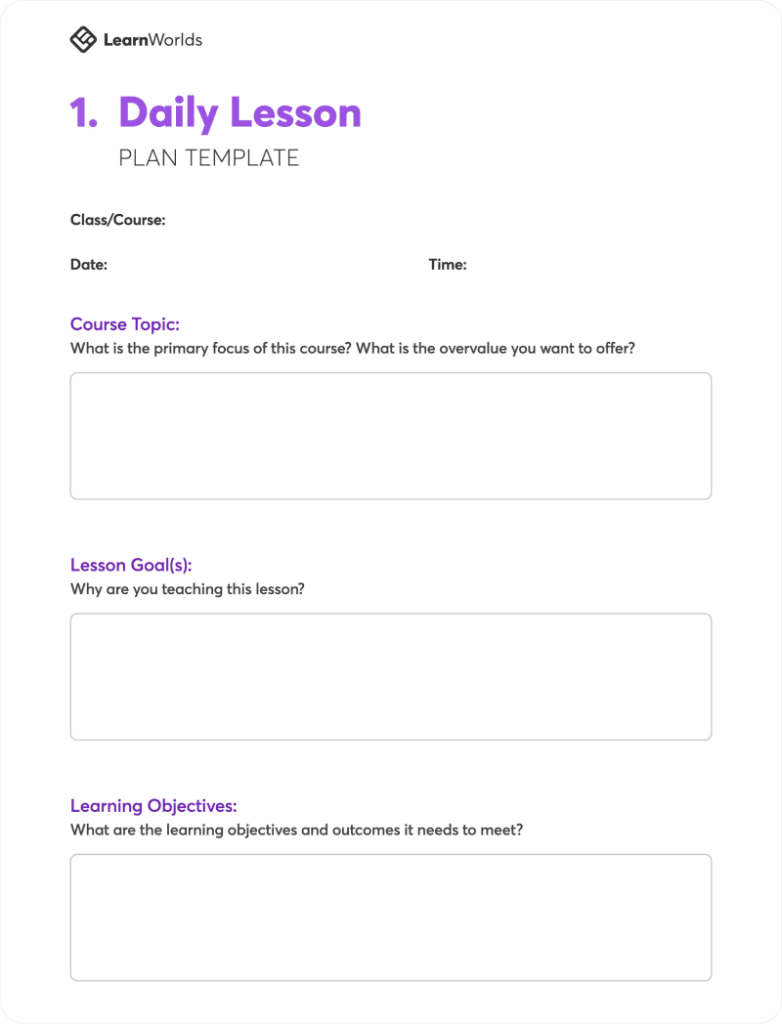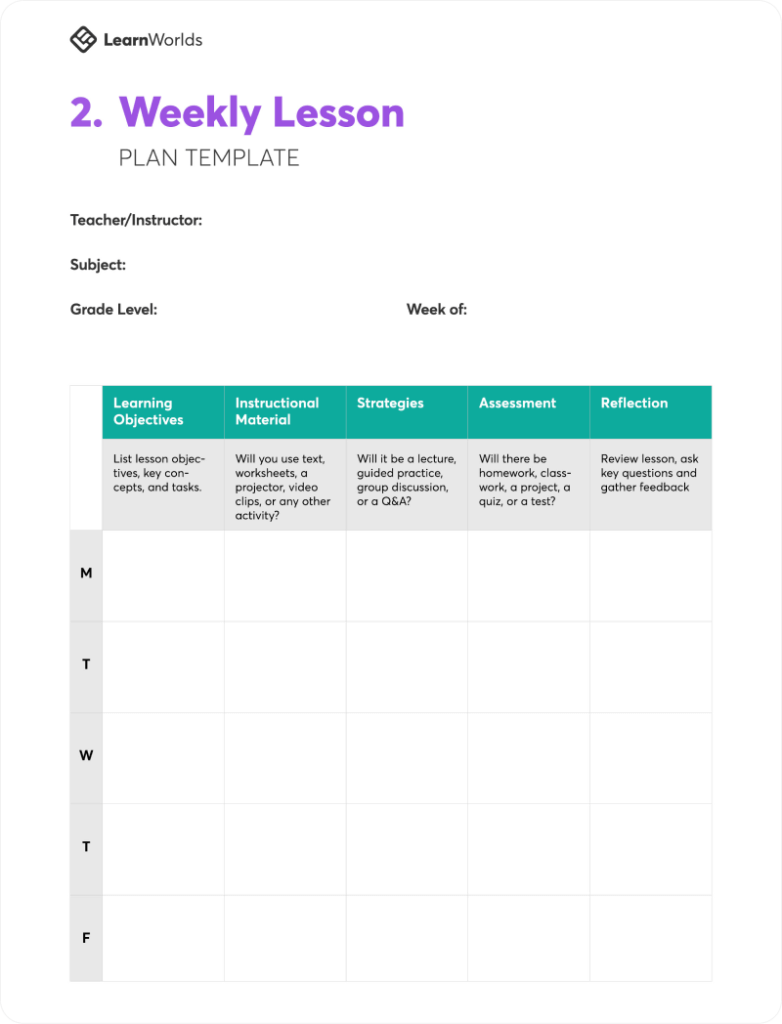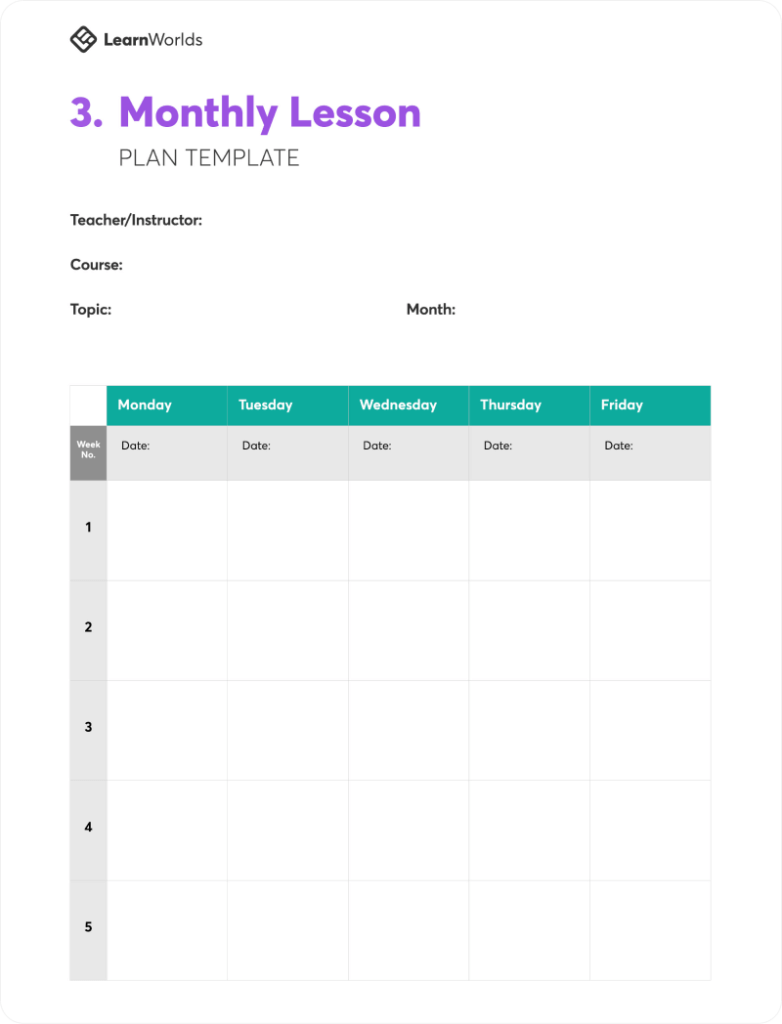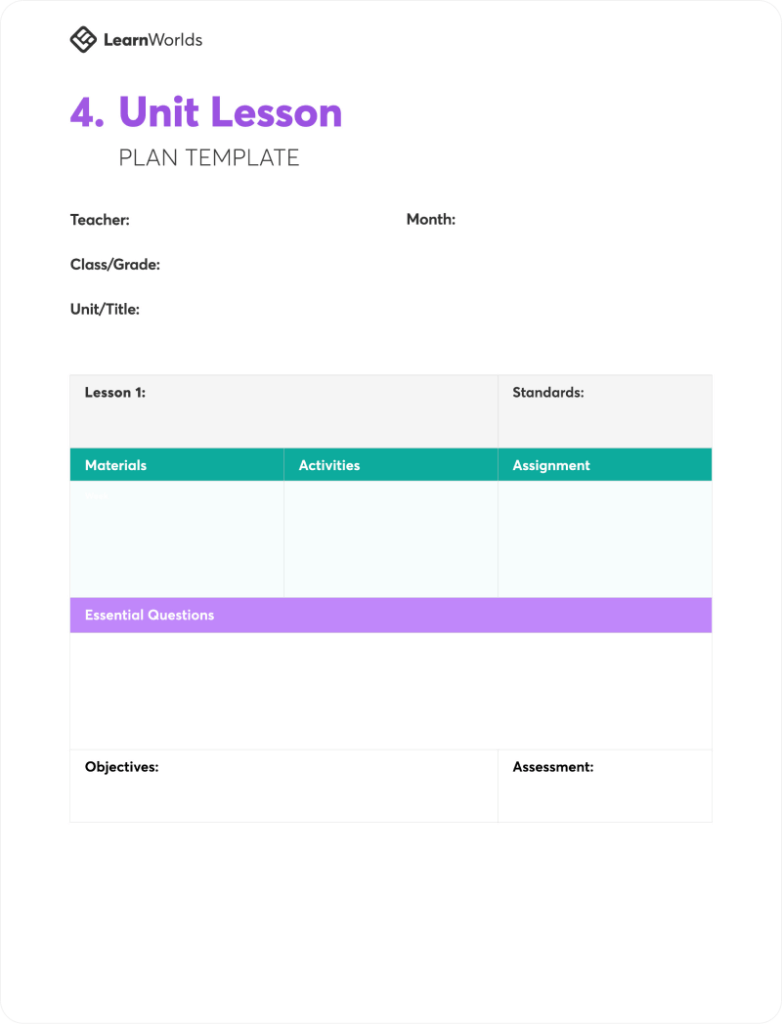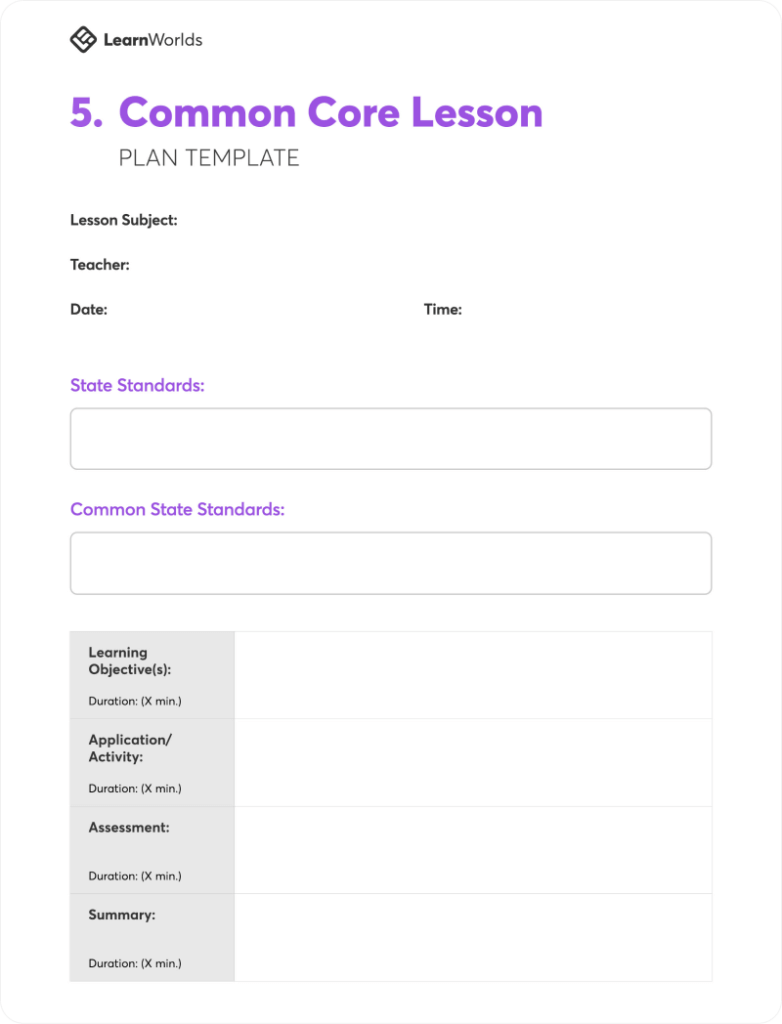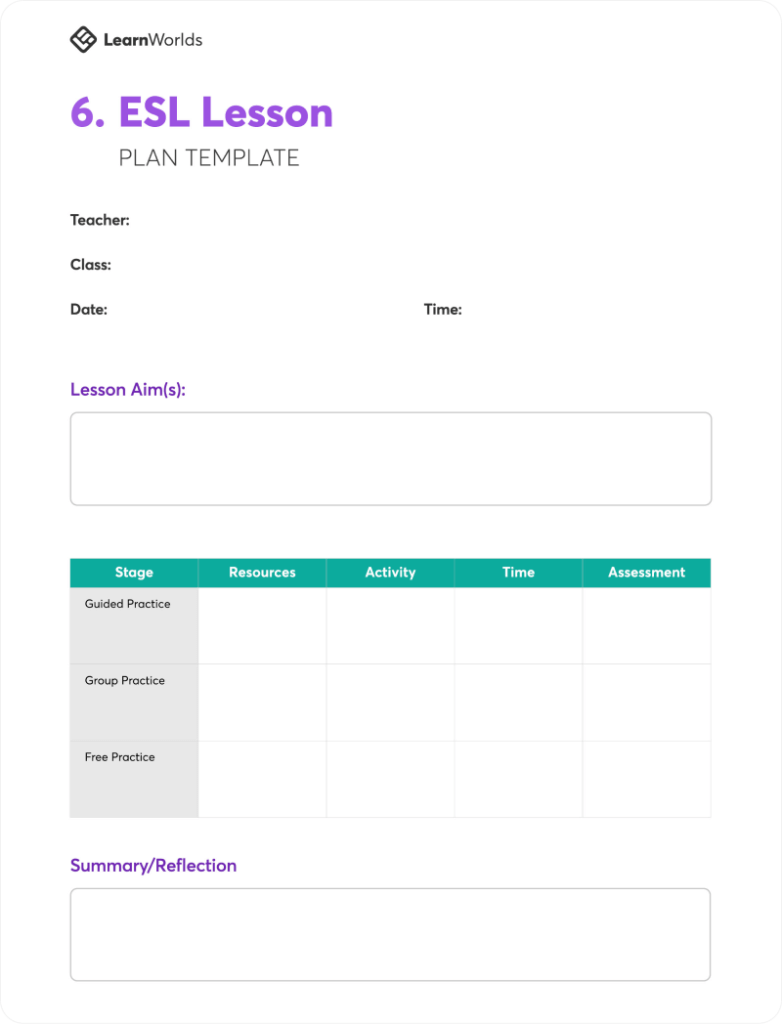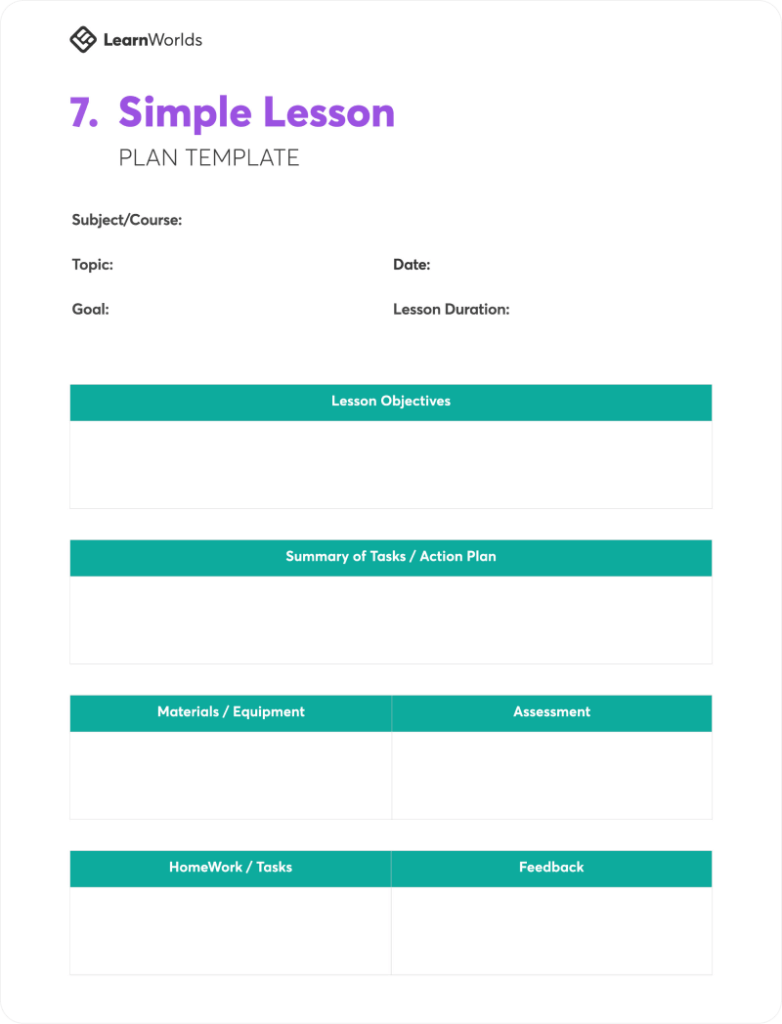Table of Contents
Looking for lesson plan templates to get you started with your own preschool lesson plan for primary, secondary, or higher education or even for your business training? Well, you are at the right place!
Just like every other educator out there, you need to come up with a lesson plan to help you give a basic structure of the class or the live session you will be delivering to your learners.
Effective lesson plans begin with having some learning objectives in place, which can help you organize your instructional materials and teacher resources and prepare the best learning activities for your students.
Whether you are a new teacher in primary education (at a pre-k or elementary or middle school) or a business trainer at a middle-sized company or a large enterprise with special education and training needs, you need a good lesson plan at hand to deliver effective and engaging learning.
In this article, you will learn how to create a good lesson plan and will get access to free printable lesson plan templates that you can use right away.
Let’s go!
What is a Lesson Plan?
A lesson plan is a detailed guide that outlines the instructional objectives, content, activities, materials, and assessment methods for a specific teaching session or unit. It serves as a roadmap for educators to organize and structure their teaching, ensuring that learning goals are met effectively within a given timeframe.
A good lesson plan typically includes:
A well-crafted lesson plan that includes this information can help you stay organized and focused while remaining flexible enough to adapt to your students’ needs.
What are the Different Types of Lesson Plans?
Many types of lesson plans allow you to structure your class material and make your students’ learning more effective. Creating a lesson planner just for a single session, e.g., for a one-off activity for a small group, may take up to a whole day, a week, a month, or constitute an entire course.
Luckily though, blank lesson plan templates can be of huge help here!
They can help categorize a lesson plan as either detailed, semi-detailed, or understanding by design (UbD) and tell you a bit more about each one’s characteristics:
A well-structured lesson plan template is immensely significant, whether for a school classroom or a business training session, as it serves as the cornerstone for effective teaching and learning.
First and foremost, such a template provides a clear roadmap for trainers, ensuring that they cover all essential topics and objectives in a systematic and organized manner. This helps to maintain consistency in training delivery across different sessions and trainers. Training sessions may become disjointed without a structured plan, leading to knowledge gaps and less clarity among employees.
Moreover, a well-designed training lesson plan template promotes effective learning outcomes. It allows trainers to align their content with specific learning objectives and desired competencies, which in turn helps employees grasp and retain information more efficiently.
This structured approach also facilitates assessments and evaluations, making it easier to gauge the effectiveness of the training program. In essence, a business that invests in creating and utilizing a well-structured training lesson plan template is more likely to see improved employee performance, reduced onboarding time, and enhanced overall productivity, ultimately contributing to its long-term success in a competitive marketplace.
Most Common Lesson Plan Formats
While every teacher or instructor has their unique approach, certain lesson plan types have emerged as go-to formats across various educational settings.
This section will explore the most widely used lesson plan structures, each offering distinct advantages for different learning objectives and teaching styles.
In doing so, it also features some great education lesson plan examples:
Example #1: Daily, Weekly, or Monthly Lesson Plan
A daily, weekly, or monthly lesson plan outlines all the activities you plan to do and all the content you have lined up until the end of the day, week, or month.
The lesson plan starts by listing the focus and goals of the course/lesson, as shown in the daily lesson plan example below. At the end of each class, the lesson plan prepares students for the next class and lists any assessments that need to be completed, such as exercises, chapter exams, projects, etc.
This type of lesson plan falls into the detailed lesson plan structure and can help you maintain a routine and keep track of your teaching schedule while conforming to any state standards. It’s also handy for distance learning.
Here’s an example of a weekly lesson plan:
And, here’s an example of a monthly lesson plan:
Best for:
Example #2: Unit Lesson Plan
Another way to plan your instruction is by using a unit lesson plan. With unit planning, you list all lesson objectives along with a projected completion time frame. Each unit offers certain activities and learning experiences using many types of learning that make up a systematic method of instruction on a subject matter (e.g., social studies, physical science, and so on).
Check out this example of a unit lesson plan:
Although unit lesson plans tend to follow a systematic approach, there is some flexibility in what is covered each day. As such, it falls in the semi-detailed lesson plan structure.
Best for:
Example #3: Topic or Subject Lesson Plan
This lesson plan is structured around a specific topic or subject and falls in the detailed lesson plan format. Whether this is Science, Maths, English, Music, Art, or any other specialty, it can be used to offer thorough knowledge in a specific academic subject or a professional niche.
It is a versatile lesson plan that can be applied to various educational contexts, including homeschooling. It can help teach common core subjects and provide a structure for parents or tutors teaching children at home.
It also applies to language instruction, particularly useful for teaching English as a Second Language (ESL) or English as a foreign language (EFL), and foreign language education, teaching popular languages such as Spanish, French, Mandarin Chinese, German, Japanese, and others.
Best for:
Example #4: Elearning Lesson Plan
An elearning lesson plan offers a structure that is broken down into smaller parts that help students make sense of the information presented. It can either be detailed or semi-detailed.
However, since online lessons don’t have the immediacy of classroom lessons, a teacher must do a lot to convey this. You can use a simple lesson plan structure (like the example below), but make a note to incorporate various interactive media, such as visuals, video, and audio, in your activities to help students get the most out of the lesson and keep them engaged at all times.
Best for:
As you can see, each lesson plan is different, and as a teacher, you need to experiment with other formats to find out which works best for you and matches your teaching style.
Other Key Things to Consider: Education Level & Standards
While at it, you must also consider the learning curriculum. This needs to be appropriate for the grade level you are teaching and should align with the geographical standards set by the country where you teach.
Perhaps you can be more specific here as well, targeting a certain student age group and crafting any of the following:
A preschool lesson plan should be flexible and engaging for the youngest children (3-5 years) not attending school. It consists of activities designed to work throughout the lesson, with the understanding that timing may vary due to the children’s age.
Resources can be diverse and adaptable, allowing for spontaneity and adjustment based on the children’s interests and attention spans. The focus should be on creating a fun, nurturing environment that promotes early learning through play, exploration, and social interaction.
Similarly to preschoolers, kindergarten students (4-6 years) will need much attention. You can work with the standard lesson plan template, but you must be creative and flexible to adjust your plan on the day to ensure continuous participation.
At the same time, you must align your lesson activities with the core subjects they need to become more familiar with, e.g., math and language arts, science, music, physical education, etc. The goal is to introduce fundamental academic concepts while fostering a love for learning and supporting overall development.
Elementary school lesson plans (for ages 6-11) are structured and subject-focused, aligning with grade-level standards. They balance whole-class, small-group, and individual activities across core subjects.
Plans integrate technology and hands-on experiences to enhance engagement. Regular assessments and differentiated instruction accommodate diverse learning styles. A typical lesson includes a warm-up, main presentation, guided practice, independent/group work, and assessment wrap-up.
High school plans (for ages 14-18) are complex and subject-specific, emphasizing critical thinking and career preparation. They incorporate diverse teaching methods, including lectures, discussions, projects, and labs. Plans often integrate current events, digital resources, and cross-curricular connections.
They provide opportunities for student-led learning and independent research. Lessons may span multiple days and include regular assessments. A typical structure includes a warm-up, review, introduction of new content, guided practice, independent work, and a wrap-up with assessment.
In addition to the education level aspect, you should align your educational content with the geographical standards of the country where you teach.
For example, if you are a K-12 (elementary to high school) teacher and live in the US, you must ensure your teaching materials meet the Common Core* standards.
*Common Core is a set of high-quality standards used in maths and English language arts/literacy (ELA), and they outline what a student needs to know and be able to do at the end of each level.
The Basic Components of Lesson Planning
As we’ve explained, a lesson plan is the teacher’s guide for running a lesson. It includes the lesson goal(s)—what the students need to learn by the end of the class—and the method that describes how the goal will be achieved.
It also includes the way of measuring how the goal was achieved, usually through a test, a worksheet activity, or homework.
A lesson plan ensures that you approach the teaching process effectively and is summed up with the following steps:
Step 1: Set the learning objectives
First, you will need to set the lesson objectives. Ensure these are clear and follow a logical order that is easy to understand and helps students identify meaningful concepts and ideas.
A learning objective is what you want students to learn by the end of the class. Communicating the importance of the lesson you are teaching and focusing on your learning objectives will encourage students to put in the time and effort required.
Step 2: Identify the needs of the students
Let students know what you expect from them; however, make sure you are prepared to help them along the way. Every student is different, and some might need more encouragement or assistance from you than others.
Make time for such interventions or check-ins in your lesson plan. This will motivate them to actually go through the lesson, ask questions, follow your guidelines, and finally complete the assessments (e.g., any assignments you have prepared) more easily.
Step 3: Plan your teaching material
Most teachers may take this for granted, but creating a list of all the necessary teaching resources you will need can help you be more prepared.
From stationary like a pen or paper to technology equipment like laptops, software, or gamified learning tools like apps or any educational website, all these can help you get the most out of what you intend to do with your teaching.
Step 4: Present the outline of the lesson
Your goal throughout the lesson is to keep students engaged. A lesson outline can help them develop a context around the subject you are teaching, letting them know what is coming next, and encourage them to relate to the learning materials.
Don’t forget to draw relevant examples of events or develop creative activities that spark interest and attention.
Step 5: Instruct the lesson
It’s time to start teaching after you have come up with the material you want to instruct. As you go through the lesson plan, follow the order and present the resources you need, but also make sure to involve students in this process.
For example, if you are following a math lesson plan, ask a few students to participate by solving a problem or ask a student a specific question.
You may use as much multimedia as you want to facilitate engagement and give a wealth of examples students can relate to easily – from simple PowerPoint Slides to exciting graphics on a computer. What’s important here is presenting information in a meaningful way.
Step 6: Give students time to practice
Once you finish your instruction, it’s the students’ turn to take the lead. Ask them to show what they have learned through practice.
To help them out, start with guided practice, allowing students to make sense of the information they have just received. Then, follow with the collaborative process, letting students work in groups to explore the main concepts.
Finally, finish with independent practice, giving each student time to work independently through an assignment (e.g., worksheet, essay).
Step 7: Do a wrap-up
As the lesson ends, give an overview of what has been discussed and what students have learned. Ask them to identify the key takeaways of the lesson, announcing the main ideas and conclusions. Assign homework duties and give them a preview of the next lesson to prepare them.
Step 8: Evaluate the lesson
Once the lesson is over, determine whether the learning objectives have been met, and ensure that students have understood what you taught through a small quiz, test, or exam. The results should give you enough insight into students’ understanding and will help you decide whether the class needs a review or not so that you are ready to move on to the next lesson.
Best Customizable Lesson Plan Templates [Editable Format]
Just like there are many types of lesson plans, there are also many ways to create them.
We have prepared a comprehensive set of unique lesson plan templates in PDF format to help you gather some inspiration to structure your own lesson plan. You can choose to use them right away or customizing them further to suit your needs.
Inside the PDF, you will find the following lesson plan templates:
These are all editable lesson plan templates you can easily access, adjust, or save for later.
PS: We’ve already included the templates for you in the article to check out firsthand.
Every template in this list works as a guiding framework for addressing important lesson information such as learning materials used, essential questions, learning goals, activities, evaluation, feedback, and more!
Choose the sample lesson plan that you prefer and make any adjustments to suit your instructional style.
Alternatively, you can find free lesson plan templates on Microsoft’s PowerPoint, Google Slides, Google Docs or in tools like Canva and Venngage, to name a few, or even create yours from scratch using Microsoft Word.
Ready to Plan Your Next Lesson?
When it comes to elearning, creating a clear-structured lesson plan is always helpful. It enables optimized classroom management, sets the mood, introduces the lesson’s learning objectives, and prepares you and your students for success!
Having access to sample lesson plan templates can also make the creation process easier and quicker. So, take advantage of our free printable lesson plan templates to guide your online instruction and assemble your next well-crafted lesson plan.
If you are ready to plan your next lesson and deliver it to your students using LearnWorlds, make sure to get your 30-day trial for free today!
Rosemary is LearnWorlds’ Content Marketing Manager. She has over 2 decades of experience in omnichannel marketing and content writing for the IT and SaaS industry. Her expertise lies in crafting effective content marketing strategies that attract, engage, and nurture customers, enabling LearnWorlds to reach its target audiences with precision.
Kyriaki is a Content Creator for the LearnWorlds team writing about marketing and e-learning, helping course creators on their journey to create, market, and sell their online courses. Equipped with a degree in Career Guidance, she has a strong background in education management and career success. In her free time, she gets crafty and musical.
FAQ
Everything you have ever wondered, but where too afraid to ask...

